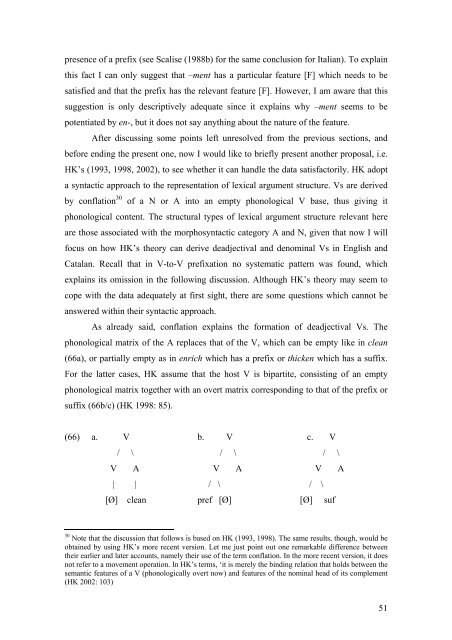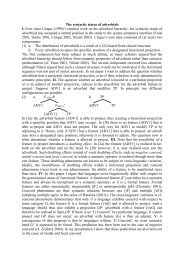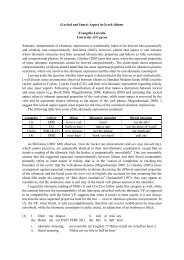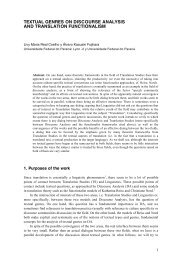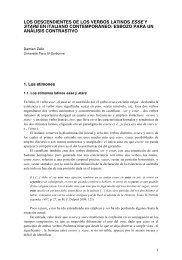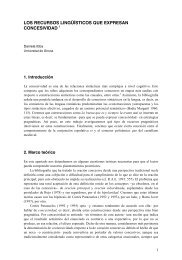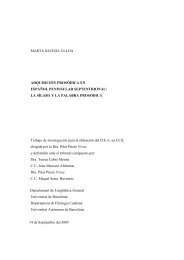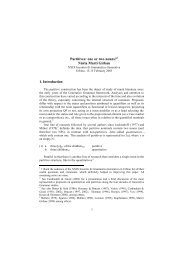Prefixation in English and Catalan - Departament de Filologia ...
Prefixation in English and Catalan - Departament de Filologia ...
Prefixation in English and Catalan - Departament de Filologia ...
You also want an ePaper? Increase the reach of your titles
YUMPU automatically turns print PDFs into web optimized ePapers that Google loves.
presence of a prefix (see Scalise (1988b) for the same conclusion for Italian). To expla<strong>in</strong><br />
this fact I can only suggest that –ment has a particular feature [F] which needs to be<br />
satisfied <strong>and</strong> that the prefix has the relevant feature [F]. However, I am aware that this<br />
suggestion is only <strong>de</strong>scriptively a<strong>de</strong>quate s<strong>in</strong>ce it expla<strong>in</strong>s why –ment seems to be<br />
potentiated by en-, but it does not say anyth<strong>in</strong>g about the nature of the feature.<br />
After discuss<strong>in</strong>g some po<strong>in</strong>ts left unresolved from the previous sections, <strong>and</strong><br />
before end<strong>in</strong>g the present one, now I would like to briefly present another proposal, i.e.<br />
HK’s (1993, 1998, 2002), to see whether it can h<strong>and</strong>le the data satisfactorily. HK adopt<br />
a syntactic approach to the representation of lexical argument structure. Vs are <strong>de</strong>rived<br />
by conflation 30 of a N or A <strong>in</strong>to an empty phonological V base, thus giv<strong>in</strong>g it<br />
phonological content. The structural types of lexical argument structure relevant here<br />
are those associated with the morphosyntactic category A <strong>and</strong> N, given that now I will<br />
focus on how HK’s theory can <strong>de</strong>rive <strong>de</strong>adjectival <strong>and</strong> <strong>de</strong>nom<strong>in</strong>al Vs <strong>in</strong> <strong>English</strong> <strong>and</strong><br />
<strong>Catalan</strong>. Recall that <strong>in</strong> V-to-V prefixation no systematic pattern was found, which<br />
expla<strong>in</strong>s its omission <strong>in</strong> the follow<strong>in</strong>g discussion. Although HK’s theory may seem to<br />
cope with the data a<strong>de</strong>quately at first sight, there are some questions which cannot be<br />
answered with<strong>in</strong> their syntactic approach.<br />
As already said, conflation expla<strong>in</strong>s the formation of <strong>de</strong>adjectival Vs. The<br />
phonological matrix of the A replaces that of the V, which can be empty like <strong>in</strong> clean<br />
(66a), or partially empty as <strong>in</strong> enrich which has a prefix or thicken which has a suffix.<br />
For the latter cases, HK assume that the host V is bipartite, consist<strong>in</strong>g of an empty<br />
phonological matrix together with an overt matrix correspond<strong>in</strong>g to that of the prefix or<br />
suffix (66b/c) (HK 1998: 85).<br />
(66) a. V b. V c. V<br />
/ \ / \ / \<br />
V A V A V A<br />
| | / \ / \<br />
[Ø] clean pref [Ø] [Ø] suf<br />
30 Note that the discussion that follows is based on HK (1993, 1998). The same results, though, would be<br />
obta<strong>in</strong>ed by us<strong>in</strong>g HK’s more recent version. Let me just po<strong>in</strong>t out one remarkable difference between<br />
their earlier <strong>and</strong> later accounts, namely their use of the term conflation. In the more recent version, it does<br />
not refer to a movement operation. In HK’s terms, ‘it is merely the b<strong>in</strong>d<strong>in</strong>g relation that holds between the<br />
semantic features of a V (phonologically overt now) <strong>and</strong> features of the nom<strong>in</strong>al head of its complement<br />
(HK 2002: 103)<br />
51


